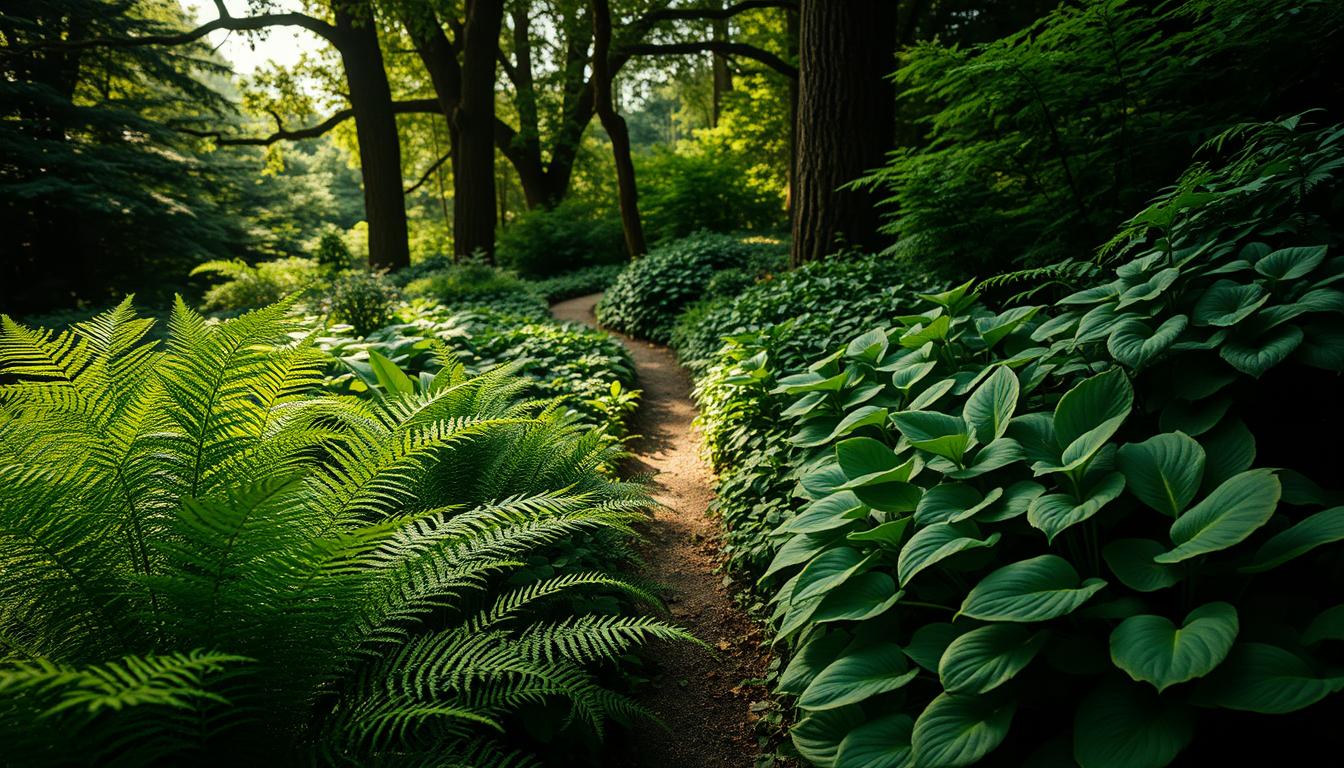Turning dark corners of your yard into green oases is doable. Many see these spots as hard to grow in. But, they can become the most stunning parts of your garden.
Learning to use limited sunlight can open new doors for your garden. Instead of seeing shade as a problem, view it as a chance to grow unique plants.
This guide will show you how to make beautiful gardens in shady spots. You’ll learn to pick the right plants and use design tricks to make the most of little sunlight.
Whether it’s under trees, in north-facing yards, or near buildings, we have solutions. With the right planning, your shaded areas can become the most magical and refreshing parts of your garden.
Understanding the Challenges of Shade Gardening
Creating a garden in low-light areas needs a special approach. Shade gardening is different from sunny spots. But, with the right strategy, these areas can be the most rewarding in your garden.
Common Misconceptions About Shade Gardens
Many think shade gardens are dull and colorless. But, this is not true. Shade gardens can be just as vibrant as sunny ones, with the right plants.
Another myth is that nothing grows in shade. But, many plants thrive in low light. From delicate flowers to lush ferns, shade gardens offer a wide range of beauty.
Some also think shade gardens need less care. While they may need less water, they still need careful planning and regular maintenance to flourish.
The Benefits of Embracing Shaded Spaces
Shade is not a limitation but an opportunity. Shaded gardens offer a peaceful retreat with unique beauty. They focus on textures, leaf patterns, and plant forms for visual interest.
Cooling Effects and Energy Conservation
Shade gardens can also save on cooling costs. By planting in south or west-facing areas, you block summer heat. This natural cooling can lower indoor temperatures, saving energy during hot months.
Reduced Watering Needs
Shade gardens need less water than sunny areas. The shade prevents fast evaporation, keeping soil moist. This makes them more drought-resistant and saves water and maintenance time.
Understanding shade gardening’s challenges and benefits lets you enjoy shaded areas. It’s about working with nature, not against it. This way, you can create a beautiful and sustainable garden.
Identifying Your Shade Type: Not All Shadows Are Equal
Mastering shade gardening starts with knowing that shadows vary. Many garden failures come from not knowing the type of shade. Plants need specific light, and so do shaded areas.
Full Shade vs. Partial Shade vs. Dappled Shade
Full shade spots get less than 3 hours of sun a day. They’re often on the north side of buildings or under dense trees. Plants that love low light do best here.
Partial shade areas get 3-6 hours of sun, usually in the morning or late afternoon. This light supports a wide range of plants, making garden design easier.
Dappled shade has sunlight peeking through trees, creating a speckled light. It’s perfect for many plants that love the woodland feel.
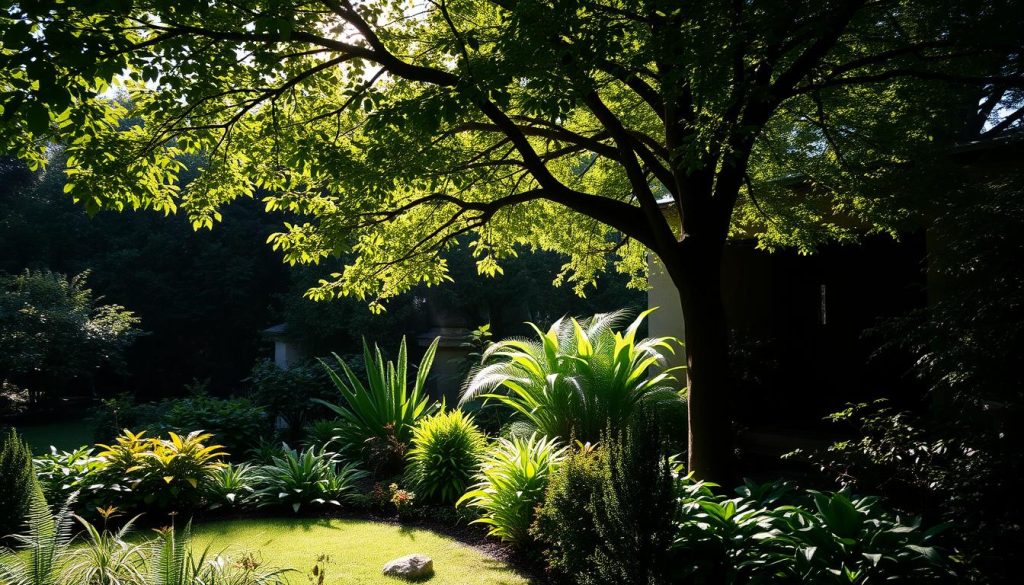
How to Assess Your Garden’s Light Patterns
To figure out your shade type, watch your garden all day. Note when sunlight hits different spots. This can reveal hidden light areas.
For a detailed look, use a sunlight meter or a light-tracking app on your phone. These tools give you exact light data for planting.
Take photos of your garden every 1-2 hours on a sunny day. These photos show your garden’s light patterns over time. They can surprise you with how much sun some spots get.
Seasonal Light Changes and Their Impact
Your garden’s light changes with the seasons. In early spring, trees are bare, letting more light in. This is a great time for spring flowers.
Summer brings dense tree canopies, deepening shade. You need plants that love true shade then. Fall’s leaf drop lets more light in again.
Winter has its own light patterns, with longer shadows but more light through bare trees. Snow can also brighten dark spots.
Knowing these seasonal changes helps you garden all year. You can plan plantings that use the changing light to your advantage. This makes your garden vibrant through every season.
Preparing Soil for Optimal Growth in Low-Light Conditions
Creating the right growing conditions in shaded areas needs special soil preparation. Shade gardens face challenges like less light, competition for moisture, and fewer nutrients. Improving the soil is key to successful shade gardening.
Soil Amendments for Shade Gardens
Shade garden soil needs different care than sunny areas. In shade, soil breaks down slower, leading to heavy, compacted soil with less life.
To improve shade garden soil, add lots of organic matter. Leaf compost is great because it’s like the natural forest floor where many shade plants love to grow.
- Leaf mold or compost (2-3 inches worked into the top 6-8 inches of soil)
- Well-rotted manure to add nutrients without burning plants
- Pine bark fines to improve drainage while maintaining moisture
- Peat moss to increase acidity for acid-loving shade plants
Addressing Drainage Issues Under Trees
Areas under trees have special drainage problems. Tree canopies block rain, and roots soak up water. But, these areas can also get too wet during heavy rains because of compacted soil.
To fix drainage without harming trees, mix in organic matter just in the top few inches. Adding fine gravel under your soil can also help water flow away from roots.
Dealing with Root Competition
One big challenge in low-light gardening is fighting with tree and shrub roots for water and nutrients. These roots can quickly take over garden beds, leaving your plants struggling.
Raised Bed Solutions
Raised beds are a great solution for shade gardens with aggressive roots. By creating a barrier and adding 8-12 inches of quality soil, new plants have a better chance to grow before tree roots get them.
For the best results, line the bottom of raised beds with landscape fabric instead of solid plastic. This lets water pass through while slowing down root invasion from below.
Root Barriers and When to Use Them
For aggressive tree roots like those from maples or willows, root barriers are a must. These barriers keep tree roots from spreading into your garden beds.
Put root barriers 2-3 feet deep and 3-5 feet from the tree trunk to avoid damaging important roots. They work best when put in place during garden setup, not later.
Top Shade-Tolerant Plants for American Gardens
Starting a shade garden is all about picking the right plants. In the U.S., some plants do better in the shade than others. The right choices can turn tough spots into beautiful gardens, just like sunny ones.
Shade-Loving Perennials: Hostas, Ferns, and Heucheras
Hostas are top picks for shade gardens, with over 3,000 types. They come in all sizes and colors, from tiny to huge. They’re easy to care for, making them great for beginners.
Ferns add a unique texture with their feathery leaves. The Japanese painted fern has beautiful silver-purple leaves. Most ferns like moist soil and consistent water.
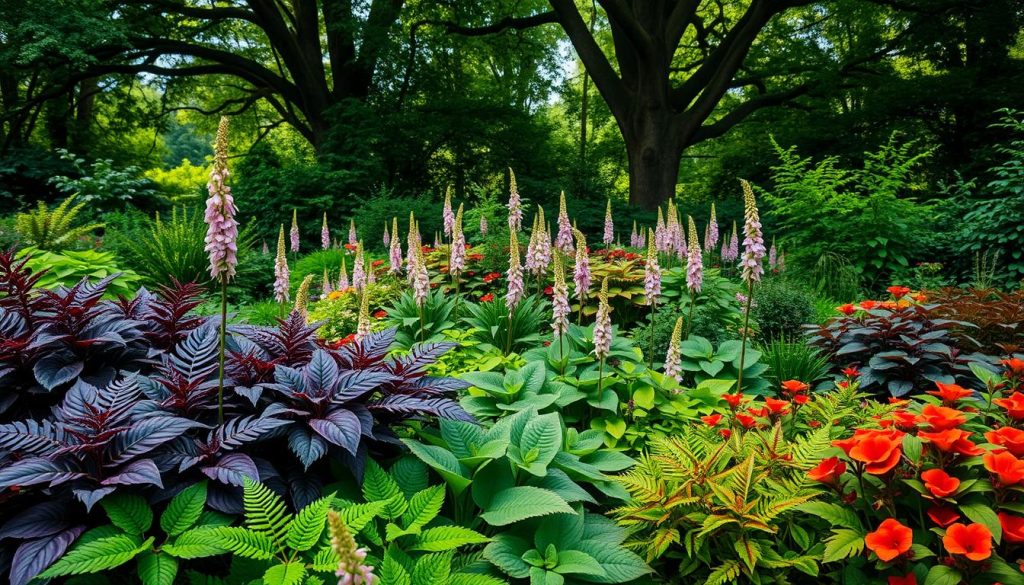
Heucheras, or coral bells, are loved for their bright colors. They do well in partial shade and keep their leaves colorful all year. Their flower stalks add interest too.
Reliable Shade Annuals: Impatiens, Coleus, and Begonias
Impatiens bring color to shady spots all season. New Guinea impatiens are better at fighting off diseases. They bloom a lot with little care.
Coleus plants are back in style with their bold colors. They have leaves in bright colors like orange and purple. They can handle more sun than before.
Begonias, like wax and tuberous types, flower well in low light. Wax begonias bloom a lot in white, pink, and red. Tuberous begonias have big, rose-like flowers in many colors.
Shade-Friendly Shrubs and Small Trees
Shade gardens need strong plants. Japanese maples look great in shade and change color in fall. Hydrangeas bloom well even in a lot of shade.
Rhododendrons and azaleas are perfect for woodlands, showing off in spring. For year-round green, try hollies and boxwoods.
Native Options for Woodland Settings
Native plants are great for shade gardens. Eastern redbud trees bloom before leaves come out. Virginia bluebells cover the ground in spring. Woodland phlox has fragrant flowers in partial shade.
| Plant Type | Light Preference | Moisture Needs | Special Features | USDA Zones |
|---|---|---|---|---|
| Hostas | Full to partial shade | Medium | Diverse foliage colors and sizes | 3-9 |
| Japanese Painted Fern | Full to partial shade | Medium to high | Silver-purple fronds | 4-8 |
| Heuchera | Partial shade | Medium | Colorful foliage year-round | 4-9 |
| Coleus | Full to partial shade | Medium | Vibrant patterned leaves | Annual (10-11) |
| Oakleaf Hydrangea | Partial shade | Medium | Fall color and exfoliating bark | 5-9 |
Proven Shade Gardening Strategies for Different Environments
Different shade environments need unique gardening strategies. Whether it’s a north-facing yard, mature tree canopies, or a woodland retreat, adapting your approach is key. By using the right techniques for your shade, you can turn tough spaces into lush gardens.
North-Facing Garden Solutions
North-facing gardens get the least sunlight, posing challenges. Use reflective surfaces like light-colored pavers or mirrors to bounce light into dark spots.
Choose plants that thrive in deep shade, like Japanese forest grass or bleeding hearts. These plants do well with little sunlight and will grow reliably in north-facing spots.
Try terraced beds facing south to catch more light. This is great for sloped properties where grading can improve growing conditions.
Under-Tree Planting Techniques
Planting under mature trees needs careful planning. Start with the toughest plants first. Groundcovers like sweet woodruff can handle tough conditions.
Avoid disturbing tree roots when planting. Create pockets of enriched soil between roots. Use raised beds in areas with severe root competition.
Watering under trees is key. Established trees shed rainwater, so supplement with deep watering. Mulch with leaf compost to retain moisture and improve soil.
Creating Woodland Gardens with Native Species
Woodland gardens thrive in shade by mimicking natural forests. Use native species that fit your region’s forest understory. Plants like trillium and wild ginger have evolved to thrive here.
Add fallen logs, moss-covered rocks, and natural mulch for woodland charm. These elements enhance looks and provide homes for beneficial insects and wildlife.
Layering Plants for Visual Interest
Woodland gardens come alive with vertical layering. Start with a ground layer of spreading plants like wild ginger. Add ferns, hostas, and astilbes for texture and interest.
Finish with an upper layer of small trees and shrubs like dogwoods. This multi-layered approach adds depth and makes the most of shaded spaces. It mimics natural forest structures where plants occupy specific heights.
Design Principles for Beautiful Low-Light Landscapes
Creating beautiful low-light landscapes means focusing on texture, form, and foliage. Shade gardens are different from sun gardens. They use subtle design elements for lasting visual interest. With careful planning, shaded spaces can become the most captivating areas of your landscape.
Using Texture and Form in Shade Gardens
Texture is key in shade gardening. Without many flowers, different leaf textures create drama and interest. Consider plants with contrasting textures:
- Bold and ribbed (hostas, ligularia)
- Delicate and feathery (ferns, astilbe)
- Glossy and reflective (European ginger, bergenia)
- Matte and velvety (heuchera, brunnera)
Form is also crucial in shade design. Plants like Japanese forest grass add grace. Foxgloves’ upright spires create structure even without flowers. Mix plants with different forms to create a dynamic composition.
Color Strategies When Flowers Are Limited
Shade gardens offer a world of foliage color. Today’s shade-tolerant plants have a wide range of colors:
- Silver and variegated leaves that catch and reflect limited light
- Deep purples and burgundies for rich depth
- Chartreuse and gold foliage that brightens dark corners
- Blue-green tones that create a cool, tranquil atmosphere
Use color echoes by repeating similar hues. Pair burgundy heuchera with dark Japanese painted fern stems. This creates cohesion and guides the eye through your garden.
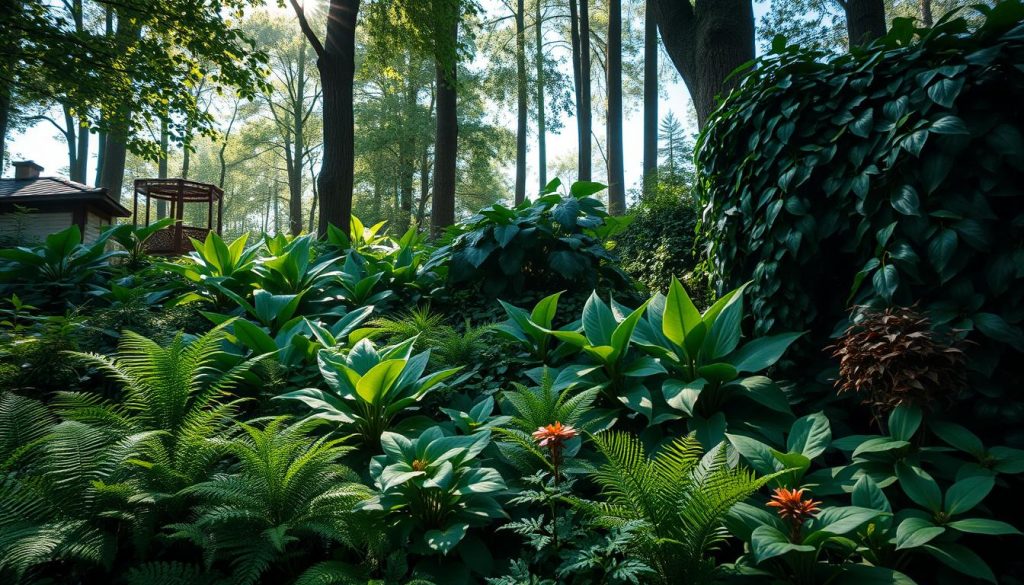
Creating Depth with Underplanting Techniques
Underplanting is key for low-light gardening. It creates layers of interest and maximizes space. Start with taller plants, then add mid-height ones, and finish with ground-hugging species.
Underplanting prevents shaded areas from looking flat. It creates a sense of journey and discovery. This layered approach mimics natural woodland settings.
Combining Ferns, Hostas and Ground Covers
Successful shade garden combinations include ferns, hostas, and ground covers. Hostas offer bold leaves in various sizes and colors. Ferns add delicate texture and movement. Ground covers like sweet woodruff or wild ginger add another layer of interest.
Group plants in odd numbers for a natural look. Place taller ferns behind medium-sized hostas, with ground covers spilling around. This combination provides visual interest through contrasting textures.
Maintenance Tips for Thriving Shade Gardens
Shade gardens need special care to thrive. They look easy, but they need attention to stay beautiful. Keeping your garden in top shape prevents problems.
Watering Considerations in Shaded Areas
Shade gardens don’t always stay moist. Trees can block rain, making the soil dry. This can harm plants.
Here’s how to water your shade garden:
- Check soil moisture regularly by inserting your finger 1-2 inches into the soil
- Water deeply but less frequently to encourage deeper root growth
- Water in the morning to reduce fungal disease risks
- Consider drip irrigation systems that deliver water directly to the soil
Mulching Practices for Shade Gardens
Mulch is key for shade gardens. It keeps moisture, stops weeds, and improves soil. But, shade gardens need special mulching.
Use 2-3 inches of organic mulch like shredded leaves or pine straw. Pull it back from plants to avoid rot. In wet spots, use less mulch to avoid fungal growth.
Pruning and Thinning for Better Light Penetration
Pruning helps shade gardens get more light. Remove lower tree branches for better light. This is called crown raising.
Thin dense shrubs by removing one-third of the oldest stems. Do this in late winter. Remove dead branches anytime.
Even a little more light can help plants in shade gardens. The goal is to make the most of the light they get.
Seasonal Care for Year-Round Shade Garden Appeal
Shade gardens can be beautiful all year with the right care. Many think they’re only for summer, but they can change with the seasons. By taking care of your garden all year, it will stay vibrant and interesting.
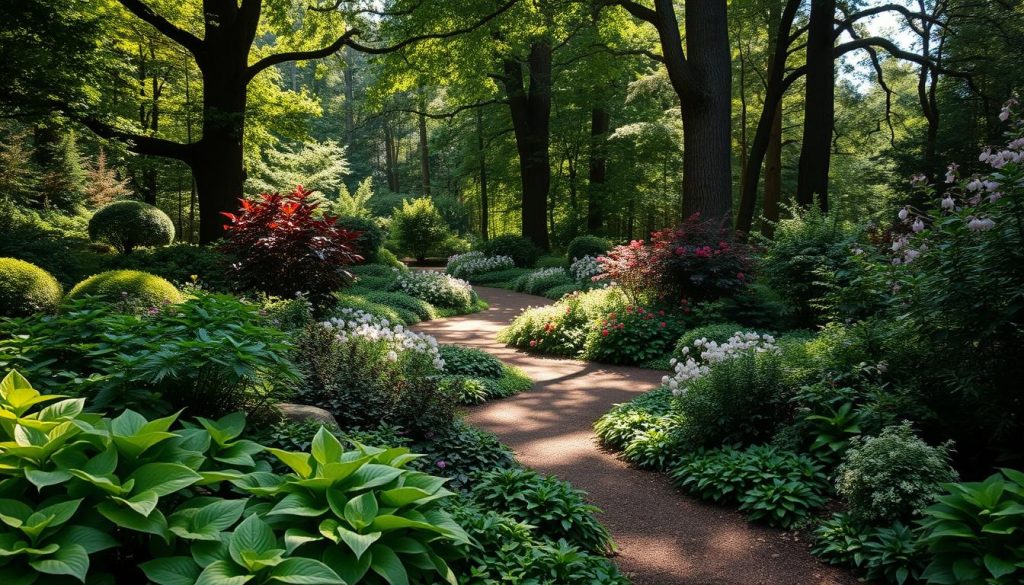
Spring Awakening: Early Season Shade Gardening
Spring is a great time for shade gardens. Before trees leaf out, they get more sunlight. This is perfect for plants like hellebores and tulips to bloom.
Use this time to move plants and add compost. It’s also when to plant new shade plants. This helps them grow strong before summer.
Summer Challenges and Solutions
Shade gardens need water in summer, even though it’s cooler. Trees block rain, making the soil dry. Water deeply but not often to help plants grow deep roots.
Watch out for pests like slugs and snails. Use copper tape or iron pellets to keep them away. Trim plants in summer to keep them looking good.
Fall and Winter Interest in Shade Gardens
When trees lose their leaves, shade gardens change. Clean up but leave some leaves for mulch. This is a good time to plan for more interest in your garden.
Evergreen Structure Plants
Use evergreens like ferns and yew to keep your garden looking good all winter. They add shape and help your garden look full even when it’s cold. Place them to guide paths and create cozy spots.
Ornamental Bark and Berries
Choose plants with interesting bark or berries for winter. Paperbark maple’s bark is beautiful in winter. Winterberry holly and beautyberry add color and food for birds. They make your garden beautiful all year.
Troubleshooting Common Shade Garden Problems
Shade gardens are beautiful but face unique challenges. Knowing how to solve these problems can turn a struggling garden into a lush oasis.
Dealing with Moss and Fungi
Moss and fungi love the shade and moisture. In woodland gardens, they add charm and help the ecosystem. But, they can be a problem on plants or paths.
To control moss on paths, mix one part vinegar with three parts water. For fungi on plants, thin nearby plants to improve air flow. Remember, mushrooms in soil mean your soil is breaking down well.
Managing Pests in Low-Light Gardens
Shade gardens face pests like slugs and snails. These pests can harm plants like hostas quickly. Use copper tape barriers or beer traps to control them.
Deer can also be a problem in shade gardens. Plant deer-resistant plants like ferns and hellebores. Change organic repellents often to keep pests guessing.
Solutions for Poor Growth and Leggy Plants
Leggy plants or sparse foliage mean something’s wrong. Check if your plants get enough light. Even shade-tolerant plants need some sun.
Prune leggy plants in early spring to make them bushy. Use slow-release fertilizer for shade plants to fix nutrient issues.
When to Relocate Struggling Plants
Transplanting a struggling plant can be the best option. Move plants in early spring or fall when it’s not too hot or cold. Water well before digging and keep as much root as possible to avoid shock.
| Common Problem | Possible Cause | Solution Strategy | Prevention Tip |
|---|---|---|---|
| Yellowing leaves | Nutrient deficiency | Apply shade-specific fertilizer | Annual soil testing |
| Leggy growth | Insufficient light | Prune or relocate plant | Match plants to light conditions |
| Slug damage | Excess moisture | Copper barriers, beer traps | Morning watering only |
| Powdery mildew | Poor air circulation | Thin plants, apply neem oil | Proper plant spacing |
Embracing the Shade: Future Trends in Low-Light Gardening
The world of shade gardening is changing in exciting ways. Gardeners are now making real woodland gardens, not just placing plants in shady spots. They focus on creating full ecosystems that help local wildlife and keep native plants safe.
Climate change is making shade spaces even more important. As it gets hotter, these cool spots are a refuge for plants that can’t handle the heat. Many gardeners are making their shade areas bigger on purpose.
New plant varieties are being bred for low-light conditions. These plants have brighter flowers and interesting leaves. They offer gardeners new ways to make dark corners colorful.
Technology is also helping shade gardening. New soil amendments and lighting solutions can make growing plants under trees better. Smart irrigation systems help with the special watering needs of woodland gardens.
Your shade garden is a chance to be creative. By using new trends, you can turn tricky areas into magical parts of your landscape. Shade gardening is getting brighter, even in the shadows.

